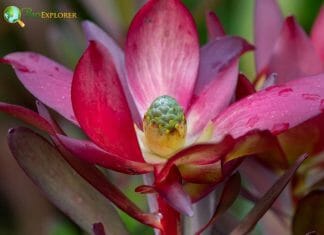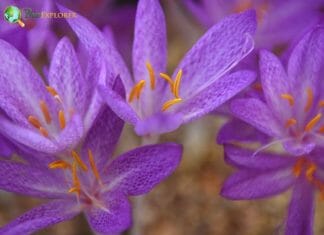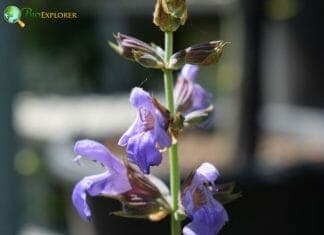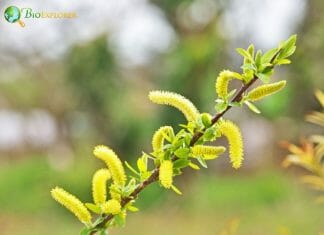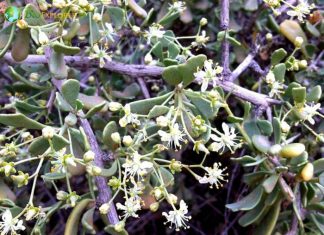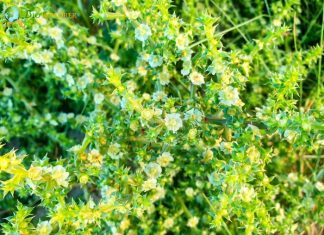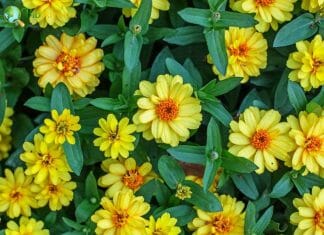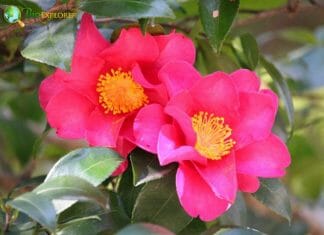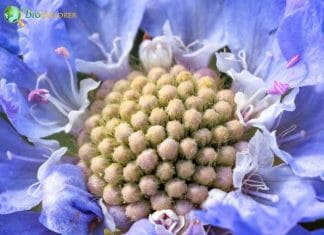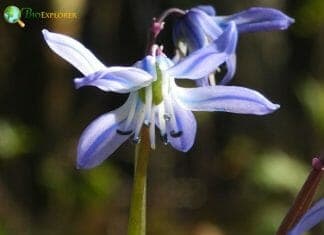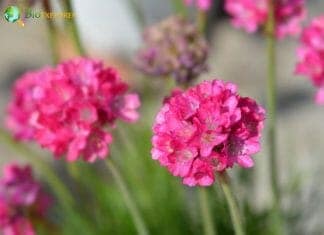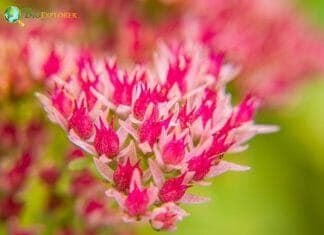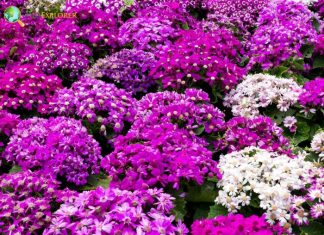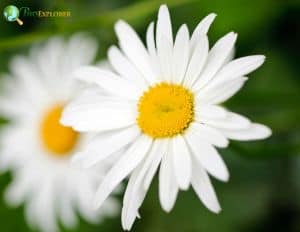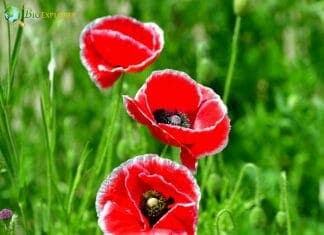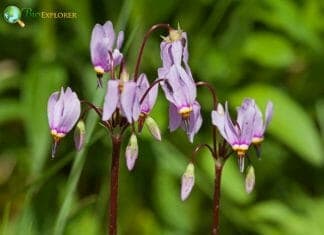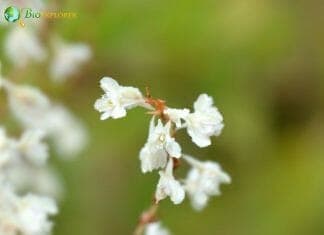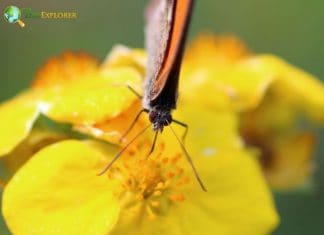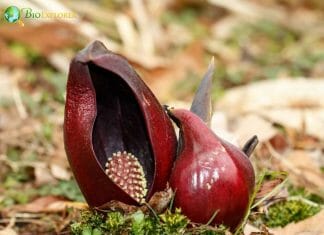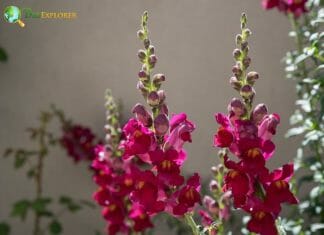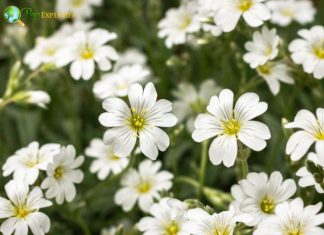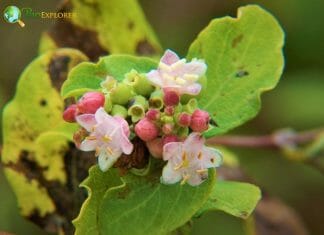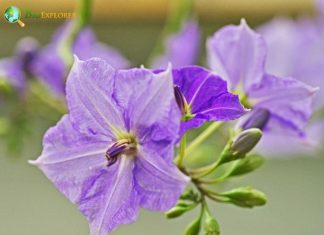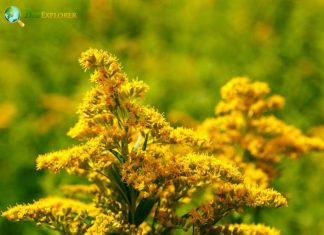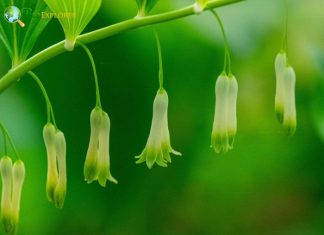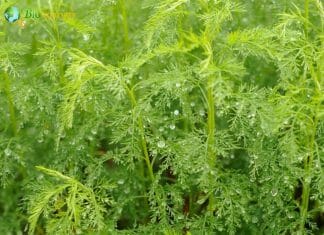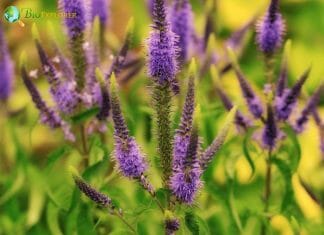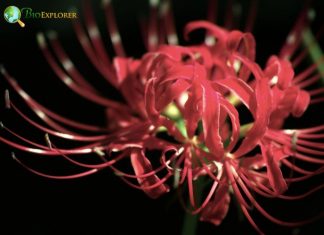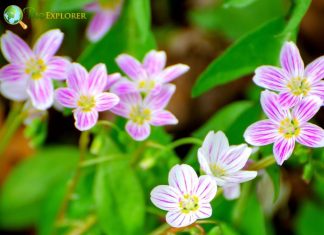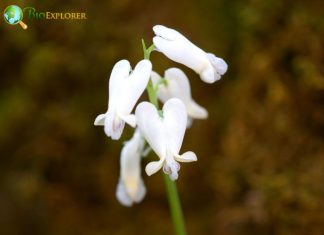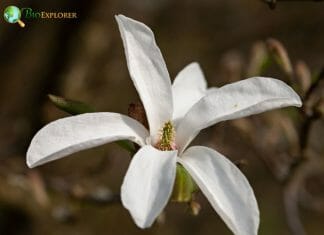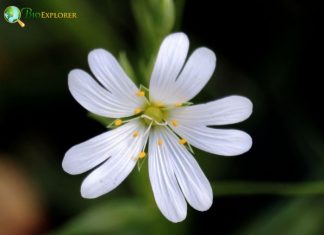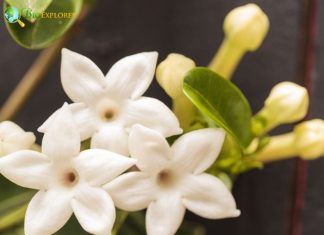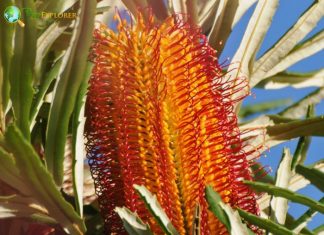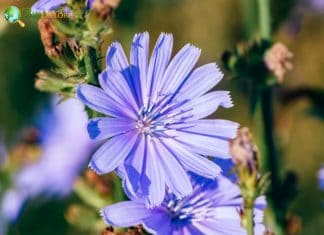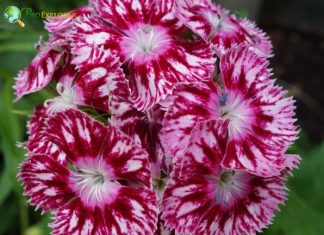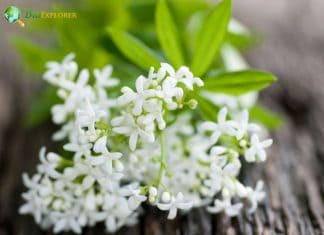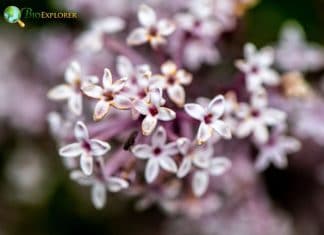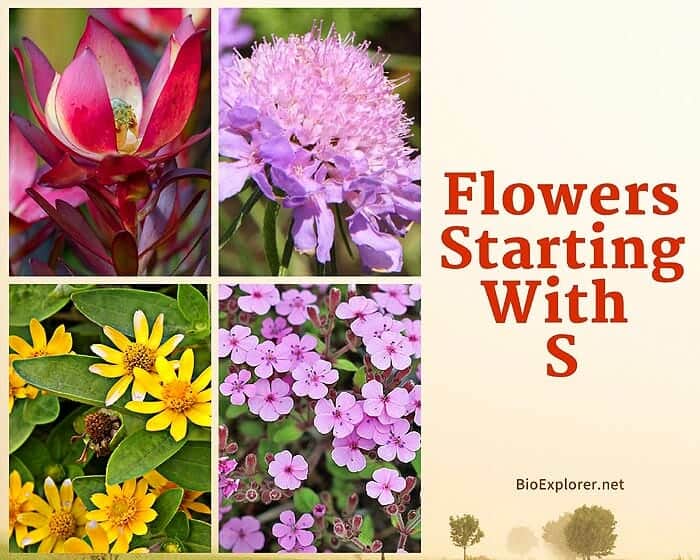
According to the University of Vermont Saffron project[1], cultivating Saffron Crocus flowers are a good revenue source for farmers to produce the most expensive spice in the world (Saffrons). You can grow Saffron flowers in the home garden to bring beauty and some sweet honey-like fragrance to your home.
Flowers Starting with S
Besides the Saffron flower, there are many other types of flowers in the plant world, starting with S.
Safari Sunset
Flower Type: Shrubs
The Leucadendron 'Safari Sunset' is a favorite of gardeners and florists is an evergreen multi-stemmed shrub with vivid, deep red bracts forming exceptionally long stalks (over 1m or 3 feet) at the tips. Perfect for use in easy-care gardens and aquifers, this tall, vigorous Leucadendron is an excellent choice for hedges, screens, or as an exhibition plant.
Saffron
The saffron flower is single and terminal, purple, and comprises 6 petals, 3 stamens, and a style that ends with 3 orange-red stigmas. Unlike other blossoms of the same genus, saffron blossoms do not close overnight. Saffron is a spice extracted from the flower of Crocus sativus, also known as saffron crocus.
Sage
Flower Type: Shrubs
From culinary to medicinal uses, sage has long been an herb garden staple. Sage is most commonly cultivated for its flavor, but it's also a relatively perennial and hardy plant in the garden. Garden sage is a medium-sized perennial shrub typically grows to between 15 to 24 inches (40 and 60 cm) in height.
Sanvitalia
Flower Type: Annuals
Sanvitalia procumbens is a cheery Mexican annual with blossoms like miniature zinnias. It is an ideal choice for containers and hanging baskets. Sanvitalia procumbens is a carpet-forming annual that usually grows up to 6-inches tall. It has a frosty summer bloom of a miniature sunflower in ¾ inches diameter with yellow to orange-yellow stripes and dark purple-brown central discs
Scabiosis
Flower Type: Annuals/Perennials
Native to Africa, Asia, Europe, and the Caucasus, Scabiosa includes around 70 species of small annual and perennial herbaceous plants that belong to the Caprifoliaceae (honeysuckle) family. These plants are mainly recognized by their unique appearance and genus name.
Scille
Flower Type: Perennials
The Scilla genus includes around 80 species of bulbous herbaceous perennial plants in the Asparagaceae family, a subfamily of the Scilloideae. Most flowers bloom in early spring, but some bloom in fall. Several species of Scilla are popular as ornamental garden plants. Each flower has 6 petal-like tepals, and each tepal has a distinctive dark blue midrib (median stripe).
Sea Thrift
Flower Type: Perennials
Armeria maritima, the sea thrift, sea pink, or common thrift, is a plant species in the family Plumbaginaceae. The genus has more than 100 species, mainly native to the Mediterranean region. It's a popular garden flower and is sold worldwide as a cut and garden flower.
Sedum
Flower Type: Shrubs
In botanical gardens or gardening stores, you may have found plants named "Sedum" that are so different that you wonder if they are related to one another. The genus Sedum is part of the large Crassulaceae (stonecrops) family named for their ability to grow in cold, dry areas with little water.
Senecio
Flower Type: Shrubs/Trees
Senecio is a genus of Asteraceae (sunflower) plants, including groundsels and ragwort. Despite dividing many species into other genera, the Senecio genus still comprises 1,250 species. The inflorescences are usually striped, with the flower heads in branching clusters, typically entirely yellow.
Shasta Daisy
Flower Type: Perennials
The cheery Shasta daisy (Leucanthemum x superbum) is a perennial classic. It resembles the well-known roadside daisies but has larger, sturdier flowers. These daisies return like clockwork every spring or early summer and bloom until early fall.
Shirley Poppy
Flower Type: Annuals
The Shirley poppy is the name of a group of annual ornamental varieties from the Papaver rhoeas (European wild poppy). There are more than 120 species of poppies in the genus Papaver of the Papaveraceae family. The Shirley Poppy was first produced in 1880 by Reverend William Wilks, pastor of the Shirley parish in England.
Shooting Star
Dodecatheon media, a shooting star, is a very popular native North American wildflower, commonly found in open woods, prairies, meadows, rocky wooded slopes, and bluff ledges. The shooting star is a plant species in the Primulaceae (primrose) family. There are more than 17 species in the Dodecatheon genus.
Silver Lace Vine
Silver Lace Vine (Polygonum aubertii) is a popular but controversial climbing plant because of its vigorous growth habit. This drought-tolerant vine wraps around porch pillars, fences, or pergolas. Polygonum is a genus of around 130 species of flowering plants in the Polygonaceae (knotweed and buckwheat) family
Silverweed
Flower Type: Perennials
Potentilla anserine, also known as silverweed, goosegrass, or silverweed cinquefoil, is a prostrate perennial herb in the Rosaceae (rose) family. Silverweed is the only plant in the Potentilla genus with pinnate compound leaves and individual flowers on separate stems.
Skunk Cabbage
Flower Type: Perennials
Skunk cabbage flower is not a real cabbage but rather belongs to a primarily tropical family of plants in the Araceae (Arum) family. There are 3 species of perennial plants in the Symplocarpus genus. This flowering plant is a low-growing plant that grows in moist hill slopes and humid areas of eastern North America.
Snapdragon
Flower Type: Annuals
Snapdragons (Antirrhinum majus) are an annual classic cultivated for generations. This annual excellent season's flowers go perfectly with violas and pansies. Around 20 species in the genus are native to the Mediterranean, from Morocco and Portugal to southern France, Syria, and Turkey.
Snow in Summer
Flower Type: Perennials
Snow-in-summer (Cerastium tomentosum) offers a solid option for adding botanical beauty to retaining wall crevices and stones in a rock garden. Additional flowering usually occurs in smaller quantities all through the summer.
Snowberry
Symphoricarpos, commonly called snowberry, ghost berry, or waxberry is a genus of around 15 species of deciduous shrubs in the Caprifoliaceae (honeysuckle) family. The flowers are small, pink to greenish-white, in most species in small clusters of 5 to 15 together, in some individually or in pairs.
Solanum
Flower Type: Shrubs/Trees
Solanum is a diverse and large flowering plant genus that includes 3 food crops of great economic importance: eggplant, tomato, and potato. The Solanum genus now contains around 1,500 to 2,000 species of plants. Its flowers are available in white, lavender, and dark purple.
Solomon’s Seal
Flower Type: Perennials
Polygonatum biflorum, commonly known as Solomon's seal, is a classic garden shade plant that gives garden beds an architectural component thanks to its arched stems. There are around 60 species in this group of perennial grasses in the Asparagaceae (asparagus) family.
Southernwood
Flower Type: Trees
Southernwood may seem like a minimal spread plant, but it has toured the world in the past few centuries. Despite its name, Southernwood is not a tree. Artemisia belongs to the family Asteraceae, which includes about 2,000 flowering plants. This plant is native to Africa and Eurasia but naturalized in scattered locations across North America.
Speedwell
Flower Type: Perennials
Veronica, also known as Speedwell, is an easy-to-grow, carefree perennial with long spikes of tiny white, pink, blue, or purple petals. With around 500 species, Veronica is the largest genus in the Plantaginaceae family of flowering plants. The precise origin of this plant cannot be exactly determined.
Spider Lily
Flower Type: Perennials
Hymenocallis littoralis or spider lily is a species of the Hymenocallis genus native to the temperate coastal areas of Latin America. Hymenocallis includes over 60 species of perennial plants. The flower is closely related to the amaryllis plant and, like its relatives, has a showy flower.
Spring Beauty
Flower Type: Perennials
Claytonia virginica is a perennial herb under the order Caryophyllales. This species is a trailing plant that can grow to 2-16 inches. Claytonia virginica has medicinal value. This plant has been used medicinally by the Iroquois for children suffering from convulsions.
Squirrel Corn
Flower Type: Perennials
Dicentra canadensis is a perennial herb with blue-gray and fernlike foliage. This species belongs to the family Fumeriaceae. The squirrel corns are natives to the east of North America. All parts of the Squirrel Corn plant are toxic only in large quantities. However, it can also cause skin rashes.
Star Magnolia
Flower Type: Shrubs/Trees
Native to Japan, Star Magnolia is a small tree that can grow to 5 to 8 feet and spread 15 ft in maturity. Star Magnolia grows well in full sun and partial shade.
Starwort
Flower Type: Perennials
Stellaria longipes, a species of plant in the Caryophyllaceae family, are known by Goldie's starwort and long stalk starwort. The Stellaria genus includes approximately 120 species of perennial herbaceous plants. There are 5 white petals, each divided into 2 lobes, sometimes flat but often so deep that they appear to have two petals.
Stephanotis
Stephanotis is a genus of the Apocynaceae (dogbane milkweed) that contains around 15 species of climbing plants native to Madagascar and Southeast Asia. Stephanotis plants are cultivated for fragrant, waxy, tubular, generally white flowers. The leaves are opposite, oval to elliptical, and leathery.
Strawberry Banksia
Flower Type: Shrubs/Trees
Banksia menziesii, also known as Strawberry Banksia or firewood Banksia, is a flowering plant of the genus Banksia. This Western Australia native contains over 75 species, all but one occurring naturally in Australia.
Sweet William
Flower Type: Trees
Sweet William (Dianthus barbatus) is a species of flowering plant in the family Caryophyllaceae native to parts of Asia and southern Europe. The flowers come in vibrant reds, pinks, whites, and two-tone hues, often with contrasting eyes and bearded petals lined on the inside.
Sweet Woodruff
Flower Type: Perennials
Sweet Woodruff (Galium odoratum) is a great statement plant in the shade garden. In spring, the plants are covered with white flowers, and the foliage gives off a sweet smell of hay. Sweet woodruff is a carpet-forming perennial most commonly cultivated as a groundcover in shady areas. There are over 600 species of flowering plants in the Galium genus.
Syringa
Flower Type: Trees
Syringa is a genus of about 12 known species of woody flowering plants in the Oleaceae (olive) family native to forests and scrublands from eastern Asia to southeastern Europe. The usual color of the flowers is violet (often lavender or light purple). Still, pink, pale yellow, white, and even dark burgundy are available.
Cite This Page
APA7MLA8Chicago
BioExplorer.net. (2025, December 25). Flowers Starting with S. Bio Explorer. https://www.bioexplorer.net/plants/flowers/s/.
BioExplorer.net. "Flowers Starting with S" Bio Explorer, 25 December 2025, https://www.bioexplorer.net/plants/flowers/s/.
BioExplorer.net. "Flowers Starting with S" Bio Explorer, December 25 2025. https://www.bioexplorer.net/plants/flowers/s/.


